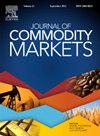Predicting commodity returns: Time series vs. cross sectional prediction models
IF 4.5
4区 经济学
Q1 BUSINESS, FINANCE
引用次数: 0
Abstract
Commodity cross-sectional models based on the commodity momentum, basis, and basis-momentum factors generate superior time-series and cross-sectional commodity return forecasts compared to the historical average and time-series forecasting models that use financial, macroeconomic, and commodity-specific variables as predictors. Timing and long-short strategies based on the commodity premium forecasts from cross-sectional models achieve significant utility gains compared to strategies based on the historical average or time series predictive models’ forecasts. Our evidence is robust across many commodities and different forecasting methodologies.
预测商品收益:时间序列与横断面预测模型
与使用金融、宏观经济和特定商品变量作为预测因子的历史平均值和时间序列预测模型相比,基于商品动量、基础和基础动量因素的商品横截面模型产生了更好的时间序列和横截面商品回报预测。与基于历史平均或时间序列预测模型预测的策略相比,基于横断面模型的商品溢价预测的时机和多空策略获得了显著的效用收益。我们的证据在许多商品和不同的预测方法中都是强有力的。
本文章由计算机程序翻译,如有差异,请以英文原文为准。
求助全文
约1分钟内获得全文
求助全文
来源期刊

Journal of Commodity Markets
Multiple-
CiteScore
5.70
自引率
2.40%
发文量
53
期刊介绍:
The purpose of the journal is also to stimulate international dialog among academics, industry participants, traders, investors, and policymakers with mutual interests in commodity markets. The mandate for the journal is to present ongoing work within commodity economics and finance. Topics can be related to financialization of commodity markets; pricing, hedging, and risk analysis of commodity derivatives; risk premia in commodity markets; real option analysis for commodity project investment and production; portfolio allocation including commodities; forecasting in commodity markets; corporate finance for commodity-exposed corporations; econometric/statistical analysis of commodity markets; organization of commodity markets; regulation of commodity markets; local and global commodity trading; and commodity supply chains. Commodity markets in this context are energy markets (including renewables), metal markets, mineral markets, agricultural markets, livestock and fish markets, markets for weather derivatives, emission markets, shipping markets, water, and related markets. This interdisciplinary and trans-disciplinary journal will cover all commodity markets and is thus relevant for a broad audience. Commodity markets are not only of academic interest but also highly relevant for many practitioners, including asset managers, industrial managers, investment bankers, risk managers, and also policymakers in governments, central banks, and supranational institutions.
 求助内容:
求助内容: 应助结果提醒方式:
应助结果提醒方式:


